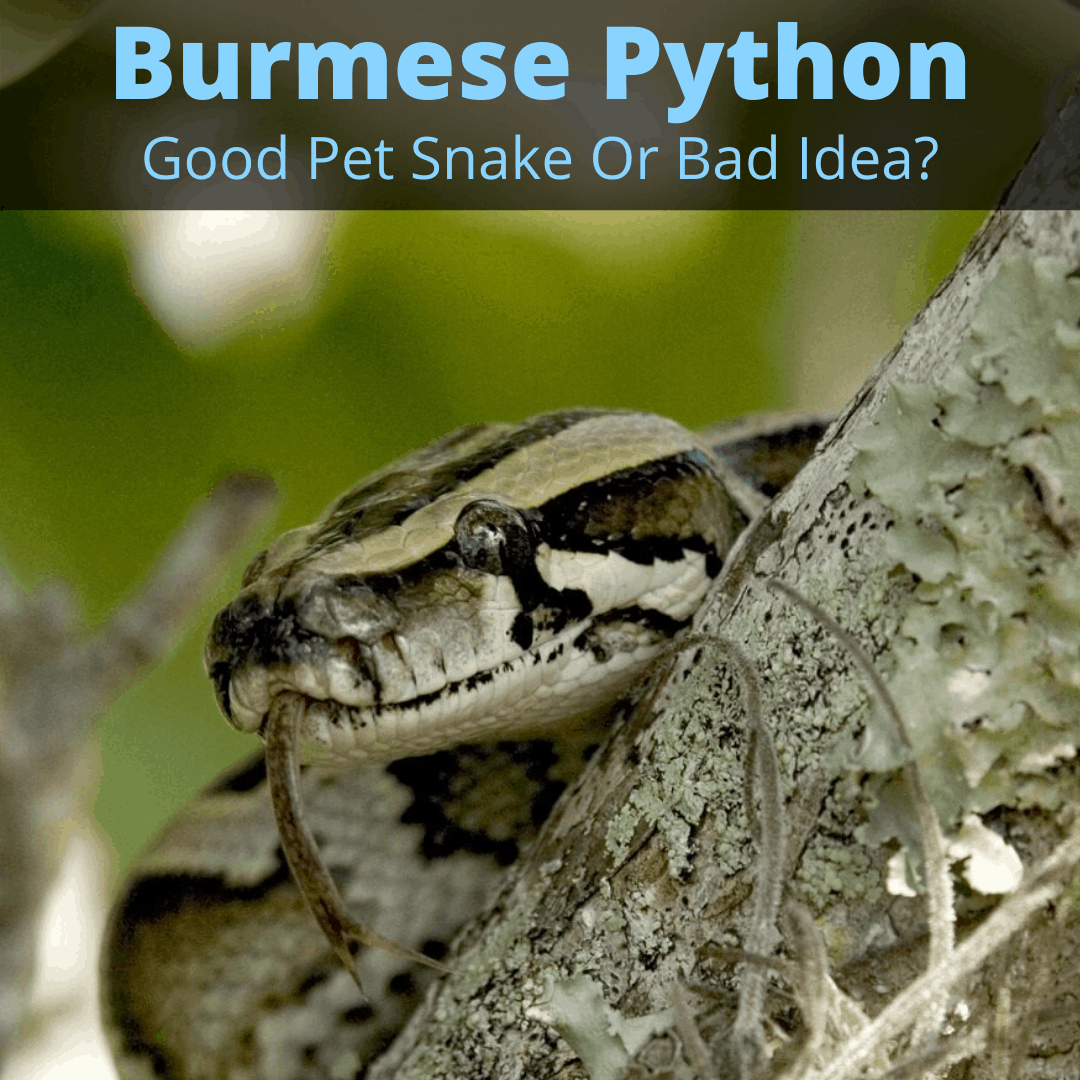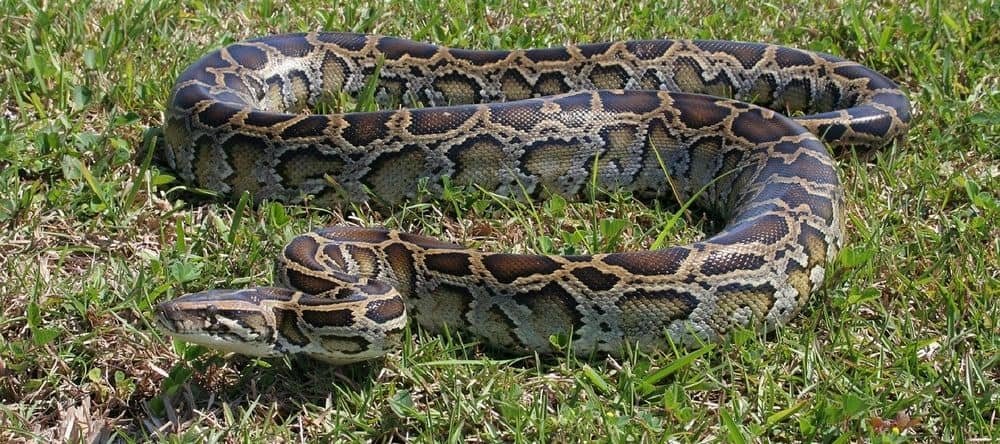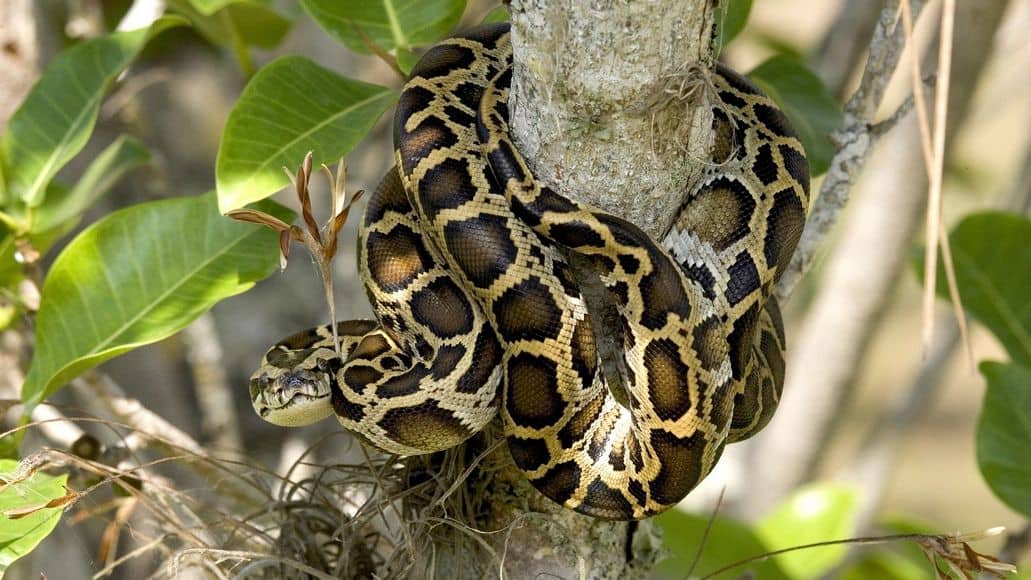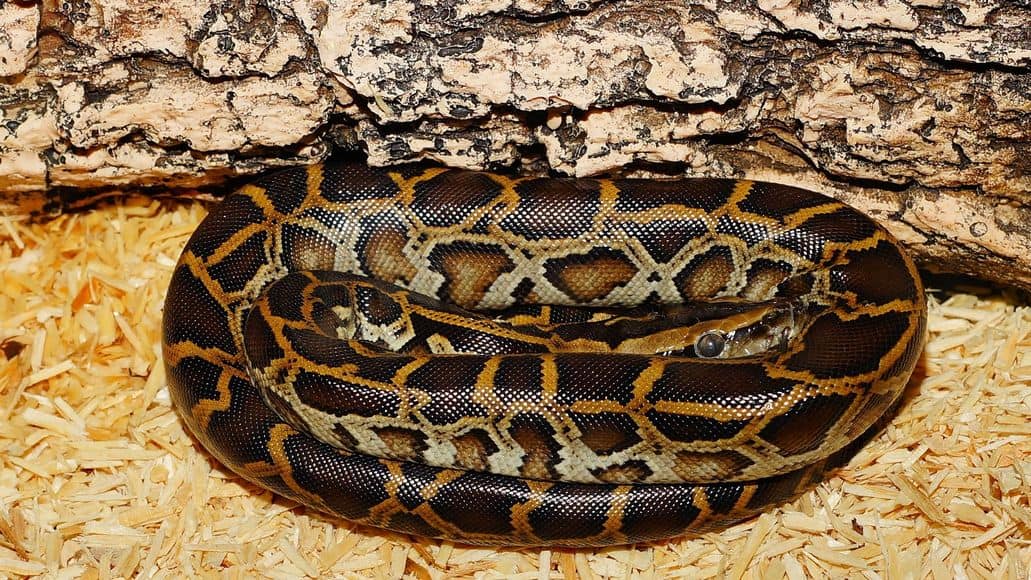
They get very large (up to 20 feet long) and require a lot of time, space, money and patience to care for. Plus they live for over 20 years.
Many owners end up abandoning their in the wild, because they can’t handle the responsibility.
For that reason, we encourage you to think long and hard about getting one. And if you have never owned any other type of snake before, you should definitely not get one.
Get a ball python first and get some experience with an easy pet snake, before moving on to one oft he more difficult ones.
But if you know what you’re getting yourself into and you can make, and keep, the commitment to care for your snake for the next 20 years or so, a Burmese python pet can be very rewarding.
Table of Contents
Burmese Python: Pet Snakes Few Should Own
Burmese pythons are generally very docile for their size, but they can still be dangerous after reaching a length of eight feet.
You definitely want to make sure you always have another person present when feeding or handling a python of that size, or even larger.
A young snake can be housed in a 55-gallon tank with newspaper bedding, but larger snakes require much larger enclosures. The largest need an entire room to live in.

The room must be especially well sealed so that the snake does not escape. Linoleum floors work well. There should be many hiding spots for the snake, such as logs, or even a tree. Be careful with lamps, because the snake could easily burn itself.
Young pythons eat mice and move up to rabbits as they grow. The prey you select for your python should be approximately as wide as its body, and should be alive.
Make sure to maintain temperatures of at least 80 degrees during the day and 70 at night. Your python will need a pan of water when young and perhaps a whole swimming pool when older.
Python Bivittatus Introduction
The Burmese Python (aka Python bivittatus) is one of the largest species of snakes on earth. In fact, it is ranked number 6 of the world’s largest snakes.
Sadly, their skins are used for leather all over the world, so they are frequently hunted in the wild. They are also popular as pet snakes among those who like to keep unusual and exotic animals.
Description
The Burmese python can grow up to 23 feet in length and weight 200 pounds, but the average snake generally tops out around 12 feet.
The coloring on their skin is usually light with black and brown dots down their whole length. It is great camouflage for the habitat they live in. Of course, this coloring is also what makes them so lucrative for poachers.

Habitat
Burmese Pythons are semi-aquatic and they live in tropical areas. They enjoy being around the water, but also spend a lot of time in trees.
They are commonly found in Cambodia and other parts of Southeast Asia (including Myanmar, which is also known as Burma and the country from which the snake takes its name), Eastern India, and China.
They can live in the jungle, the forest, the savannas, and even in rocky regions. The one constant is that they need water, so no matter where they live, you can be sure there is a source of water nearby, along with an abundant food supply.
More recently, these snakes have also been found in the Florida Everglades. They started appearing there after hurricane Andrew, when they likely escaped from homes or zoos and began mating in the wild.
This is unfortunately, since they are now wreaking havoc on the ecosystem. They are eating native species and destroying the natural balance. They are also further reducing populations of some species that are already endangered.
Behavior
Burmese pythons are primarily nocturnal creatures. They are very good climbers and spend much of their time in the trees when they are young.
As they get larger and heavier, this becomes more difficult, so older snakes spend more time on the ground and, of course, in the water.

Diet
These pythons will eat just about anything, especially if they are hungry. I’m sure you have seen photos of snakes that died trying to swallow a giant alligator…those snakes were Burmese Pythons.
They are not venomous, but kill by constriction. They use their sharp teeth to grab hold of their prey, then wrap their strong body around it and squeeze hard so it can’t breathe.
They keep squeezing until their prey dies of suffocation. Then they swallow it whole. Our article on what a Burmese python eats has much more.
Reproduction
Male snakes come looking for the females when it is time to mate. The decision is up to the females. Only if she gives the male the go-ahead, do they mate. They do the deed, then part, never to see each other again.
Females lay from 12 to 36 eggs. They hatch from March to April. Once that happens, the mother abandons them to fend for themselves. They do not leave their place of birth until after their first shed. Then they go out and hunt for food.
Danger To Humans
Burmese pythons do not have any venom, but they do bite and when they bite, they do not just let go. They can also crush us with their strong bodies so we can’t breathe.

Despite the lack of venom, a bite will hurt and it is still very dangerous. There is a high risk of bacterial infection and if it is not treated properly, that infection can spread throughout the body. If you get bitten, clean the wound thoroughly and seek medical attention.
All that said, bites are rare, because this is not an aggressive snake. The biggest danger to us is not from its bit or its ability to crush us to death, but from it upsetting the ecosystem.
As mentioned above, many of these snakes escaped into the Everglades after hurricane Andrew. In addition, there are pet owners who grow tired of having to take care of such a large snake (and one that lives for over 20 years), so they simply release it into the wild.
This species seems to thrive and will quickly upset the natural balance. That is why they have been named an invasive species.
Buying A Burmese Python
Before buying a Burmese python, make absolutely certain you know what you are getting yourself into. Taking care of one requires a lot of time, space and patience to care for it.
As mentioned, many owners become overwhelmed, resulting in captive-bred pythons being released into the wild (which is illegal in most areas, for obvious reasons).
If you are sure you can handle the responsibility, the best place to get your Burmese python is from a reputable breeder who can tell you of any health issues the snake may have.
If a breeder tries to sell you a snake that does not look like a Burmese python, claiming that it is young and will eventually take on the correct coloring when it gets older, run away. They are lying to you.
This snake has its distinct coloring from the moment it emerges from the egg. Also look for any signs of disease. These show you that a snake has not been properly taken care of. Things to look for are lethargy, redness around the mouth, wheezing breath and foam coming from the mouth when breathing.
Burmese Pythons As Pets

Housing A Burmese Python
These snakes need a very large enclosures. Carolina Custom Cages (see this post for more) have a few options that could work, but most people end up getting custom-made enclosures made from Plexiglas and wood. You can also use an entire room in your house (or a larger closet).
For younger snakes, a largish tank works fine. Something around 60 gallons is ideal. Adults need at least 8 by 4 feet of space, with at least 4 feet vertically.
Whatever you use for the housing, it needs to be strong and extremely secure. Burmese pythons have incredible strength and they are very adept at escaping.
Inside the enclosure, you need to provide smaller enclosures. Snakes do not feel comfortable unless they have snug places they can squeeze into and hide. Again, younger snakes can get hides that are similar to what you’d give smaller species, like a half log, or even just a cardboard box.
Once they get older, you’ll have to rig up some custom hides. One thing that works well is getting a couple of plastic storage bins (opaque of course, not transparent) and cutting a hole into it through which the snake can enter.
Ideally, put some moist sphagnum moss in one of the hides, to give your snake a choice of a humid or a dry hiding spot.
Substrate
Paper towels work great for hatchlings. They are easy to clean and you are able to see the snake’s excretions, which means you can quickly tell if it is sick. Avoid newspaper, but regular paper that does not have any printing on it can also work.
For larger snakes, use artificial turf or carpeting. Regular snake bedding is too expensive, considering the amount you’d need for an animal this size. Plus, this species does not burrow anyway, so carpet or turf is fine. Another good option is linoleum.
Linoleum is the easiest to clean, but even turf or carpet are not difficult. Ideally, you should have at least two pieces, and then simply swap them out when one gets soiled, so that you can clean it. After a while, you will want to replace them all entirely, since they do start to smell after they have been soiled many times.

Temperature
Pythons come from a tropical climate, so they like it warm. The ideal daytime temperature is 85° to 88° F. You should also provide a basking spot with a higher temperature. Aim for 90° to 93° F.
At night, the ambient temperature can be a bit cooler. 78° to 80° F is good. The best way to maintain temperatures is to us either lights that emit heat, ceramic heat elements, or heating mats.
Make sure heating pads are outside the enclosure or beneath the substrate (if not flammable) and that any lights or heating bulbs are shielded. If the snake gets to close, it could get burned. A pig heating blanket actually works really well for larger snakes, too.
Food And Water
These snakes like to eat and will consume whatever you give them. Therefore, it is up to you not to overfeed them. You don’t want your pet getting fat.
You can give hatchlings standard snake fare, like mice or fuzzy rats, and feed them twice a week. As they grow, you’ll need to move up in size to adult rats and then rabbits, but feed them less often (once every two weeks for fully-grown adults). A good rule of thumb is to feed them something that is about the same size as the snake is wide.
It is important to ensure that your snake always has fresh water for drinking. It also wants water to soak in, because this species likes being in the water.
For young snakes, the water dish can double as a pool. Change the water often, to ensure it is always clean. Once the snake is too big to soak in its water dish, you’ll need to provide it opportunities to get a soak in. Give it some time in a swimming pool or a tub on a regular basis.

Common Health Problems
Inclusion body disease (or IBD) is a dangerous disease that spreads from one snake to another and commonly affects pythons and boas. It is caused by a virus and is often fatal.
Symptoms to look out for include constipation, irregular shedding, loss of motor control, tremors, and anorexia. Snakes with IBD are often unable to eat, even by force, and they starve to death as a result.
Common reptile diseases also affect Burmese pythons. One of these is stomatitis, which is also called mouth rot. Stomatitis presents as a reddish discoloration inside and around the mouth. It can also be fatal.
Another common sickness are respiratory infections. You can detect a respiratory infection by the way your snake breathes. If you notice it breathing with its mouth open or wheezing, you should get it to a vet immediately.
Even when your snake seems healthy, you should take it to see a veterinarian annually. They will be able to check for more subtle signs of disease. Many animals do not show any symptoms until it is too late.
Burmese Python: Final Thoughts
The Burmese python is a difficult snake to care for as a pet. It can grow up to 20 feet in length and can live over 20 years. That is a huge commitment in terms of time, money and space. If you are not absolutely certain about this, do not get one of these snakes. Get a smaller one instead.
If you do go ahead a bring home a Burmese python pet, please be responsible. Give it the care it deserves and whatever you do, do not just abandon it, like so many have done. That isn’t fair to the snake or the the other animals in your local ecosystem, many of whom would then become snake food.

Leave a Reply